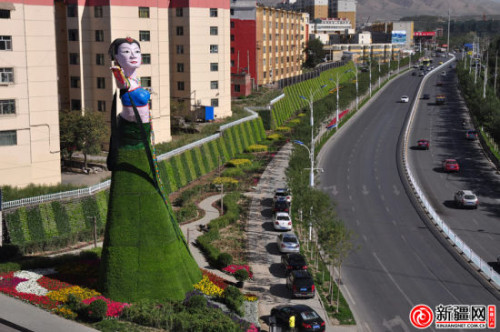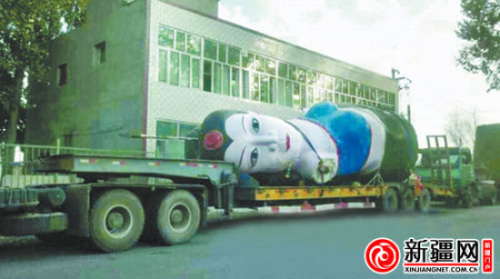
The statue of a flying Apsara stands at an intersection in Urumqi, the Xinjiang Uygur autonomous region, on Aug 6 when it was completed. The statue was demolished on Friday. Zhu Yi / for China Daily

It was dismantled by more than 20 workers and loaded by crane onto four flatcars.
A new statue in the Xinjiang Uygur autonomous region was demolished only 11 days after it was put in place, but controversy about its creation and demise still rages.
The 18-meter-high, 40-plus-ton statue at the intersection of Santunbei and Bahar roads in Urumqi, capital of the autonomous region, on Aug 6 was an image of the goddess Apsara in flight, wearing heavy makeup and a long skirt covered with colorful flowers.
The continuing positive comments on the Internet is a sign that it is missed.
Early Friday morning, it was dismantled by more than 20 workers and loaded by crane onto four flatcars, according to a report on iyaxin.com, a news portal in the autonomous region.
A micro blog about its being erected has been forwarded about 5,000 times on Sina Weibo, China's largest Twitter-like service, and the news of its dismantling has been forwarded more than 3,000 times since it was reported on Saturday.
The flying Apsara image comes from the Dunhuang frescoes in Gansu province, world famous for their beauty. But most netizens complained that the sculpture was ugly and did not represent a traditional image of female beauty.
Ablimit Mijit, an Urumqi resident, said on Monday that the semi-clothed Apsara statue was difficult for some Muslim ethnic groups to accept, and it would not give people from outside a clear understanding of the city's culture.
"A city gains beauty when it is adorned by sculptures," said Wang Shengcheng, another city resident, but he added that the sculpture's style and quality fell beneath the city's standards.
Wang also said he could not understand why such a huge statue was dismantled in such a short time and why public opinion was not solicited either before it was put up or removed.
One Urumqi resident registered a micro blog account in the name Santunbei Goddess, a reference to the statue. Since Aug 9, the blog has been followed by 420 netizens and has published 165 postings.
"I know many people were displeased with the sculpture, but I hoped the dispute will also attract more visitors to our city," said the micro-blogger, who did not want to be identified.
"I had good interaction with netizens and tried to show the positive effects the statue could have, but what surprised me is that the goddess was destroyed by the force of public opinion," he said.
"Its hasty demolition was irresponsible because it cost taxpayers a lot of money," he added.
Jiang Yuanqi, 24, a resident in Zhejiang province, said the statue was a waste of money.
"Nobody wants to spend their tax money on such a statue, so lacking in quality," she said.
The city's Renmin Square greening department, which was responsible for putting up the statue, did not comment on the cost when contacted by a China Daily reporter on Monday.
But Liu Xinying, the department's director, said on Saturday that they will take public opinion into consideration before putting up new artwork.

Copyright ©1999-2011 Chinanews.com. All rights reserved.
Reproduction in whole or in part without permission is prohibited.